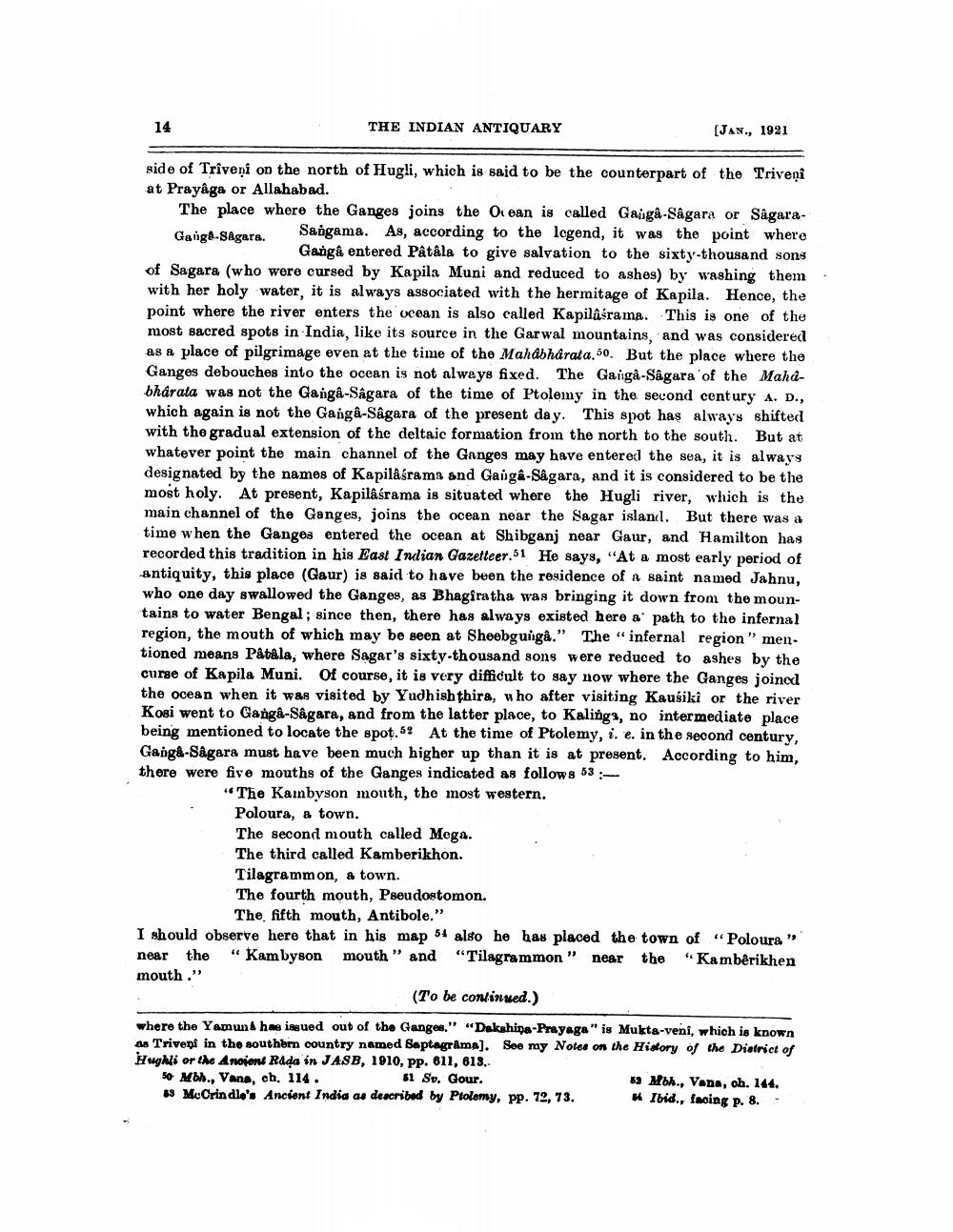________________
14
THE INDIAN ANTIQUARY
[Jan., 1921
side of Triveni on the north of Hugli, which is said to be the counterpart of the Triveņi at Prayaga or Allahabad. The place where the Ganges joins the Ocean is called Ganga-Sågara or SågaraAre Sangama. As, according to the logend, it was the point where
Gangê entered Påtala to give salvation to the sixty-thousand sons of Sagara (who were cursed by Kapila Muni and reduced to ashes) by washing them with her holy water, it is always associated with the hermitage of Kapila. Hence, the point where the river enters the ocean is also called Kapilásrama. This is one of the most sacred spots in India, like its source in the Garwal mountains, and was considered as a place of pilgrimage even at the time of the Mahabharata, 50. But the place where the Ganges debouches into the ocean is not always fixed. The Gangå-Sâgara 'of the Mahdbharata was not the Ganga-Sâgara of the time of Ptolemy in the second century A. D., which again is not the Ganga-Sagara of the present day. This spot has always shifted with the gradual extension of the deltaic formation from the north to the south. But at whatever point the main channel of the Ganges may have entered the sea, it is always designated by the names of KapilAśrama and Ganga-Sagara, and it is considered to be the most holy. At present, Kapilâśrama is situated where the Hugli river, which is the main channel of the Ganges, joins the ocean near the Sagar island. But there was a time when the Ganges entered the ocean at Shibganj near Gaur, and Hamilton has recorded this tradition in his East Indian Gazetteer 51 He says, "At a most early period of antiquity, this place (Gaur) is said to have been the residence of a saint named Jahnu, who one day swallowed the Ganges, as Bhagiratha was bringing it down from the mountains to water Bengal; since then, there has always existed here a' path to the infernal region, the mouth of which may be seen at Sheebguuga." The " infernal region" men. tioned means Påtala, where Sagar's sixty-thousand sons were reduced to ashes by the curse of Kapila Muni. Of course, it is very difficult to say now where the Ganges joined the ocean when it was visited by Yudhish thirs, who after visiting Kausiki or the river Kosi went to Ganga-Sagara, and from the latter place, to Kaling, no intermediate place being mentioned to locate the spot. 52 At the time of Ptolemy, i. e. in the second century, Ganga-Sâgara must have been much higher up than it is at present. According to him, there were five mouths of the Ganges indicated as follows 53 :
"The Kainbyson mouth, the most western. Poloura, a town. The second mouth called Mega. The third called Kamberikhon. Tilagrammon, a town. The fourth mouth, Pseudostomon.
The fifth mouth, Antibole." I should observe here that in his map 54 also he has placed the town of "Poloura” near the "Kam byson mouth" and "Tilagrammon" near the "Kambêrikhen mouth.”
(To be continued.)
where the Yamun A has issued out of the Ganges." "Dakshina-Prayaga" is Mukta-veni, which is known as Trivent in the southern country named Saptagråma). See my Notes on the History of the District of Hughli or the Anojent Rada in JASB, 1910, pp. 611, 613. 50 Mbh., Vana, ch. 114. 61 Sv. Gour.
Moh., Vana, oh. 144. 59 McCrin dlo's Ancient India as described by Ptolemy, pp. 72, 73.
* Ibid., facing p. 8.:




